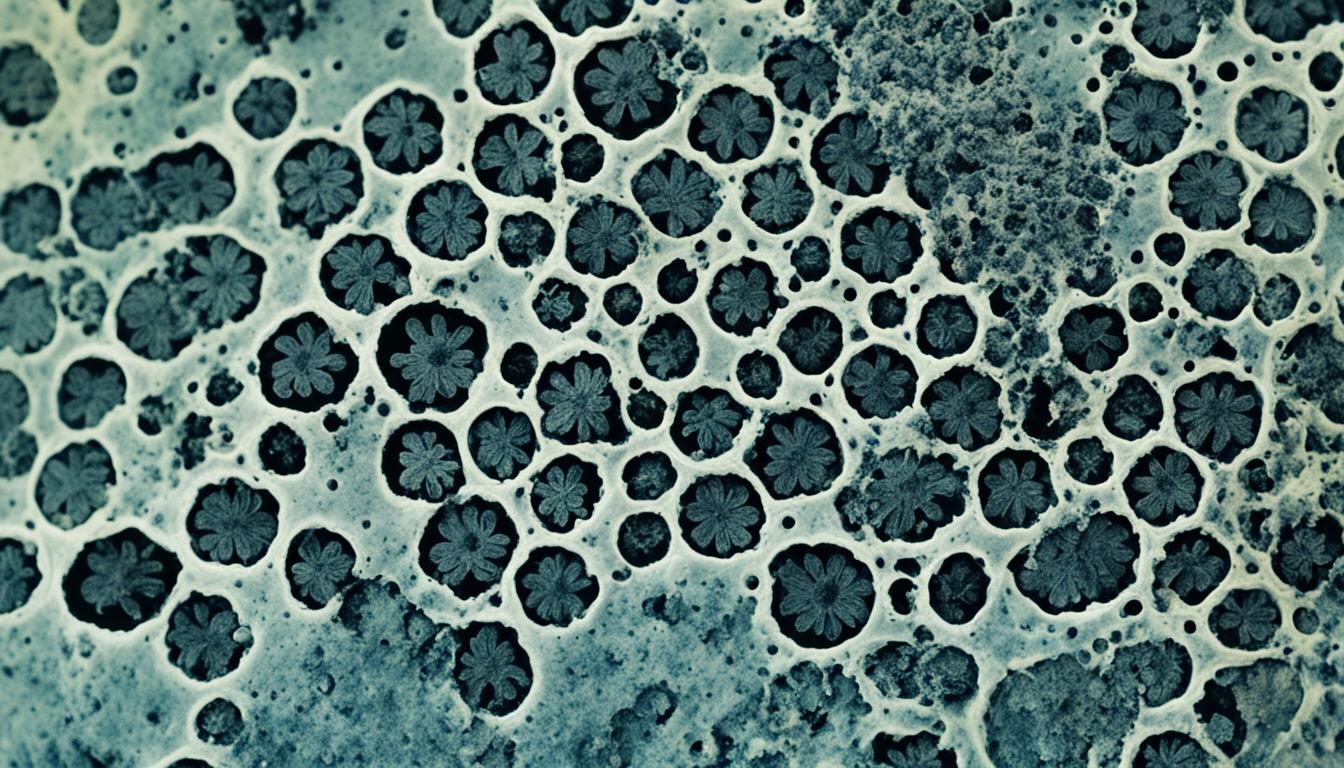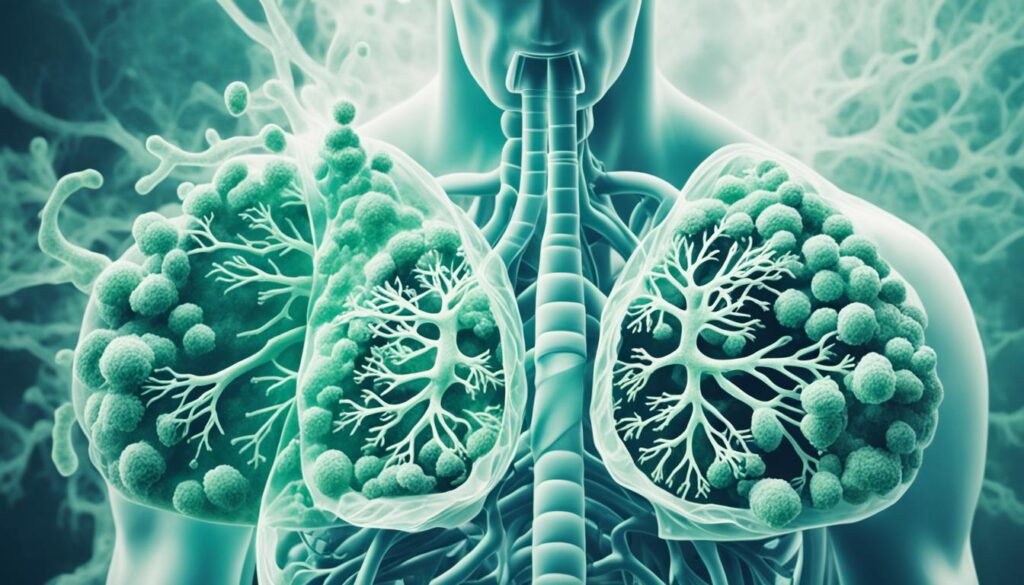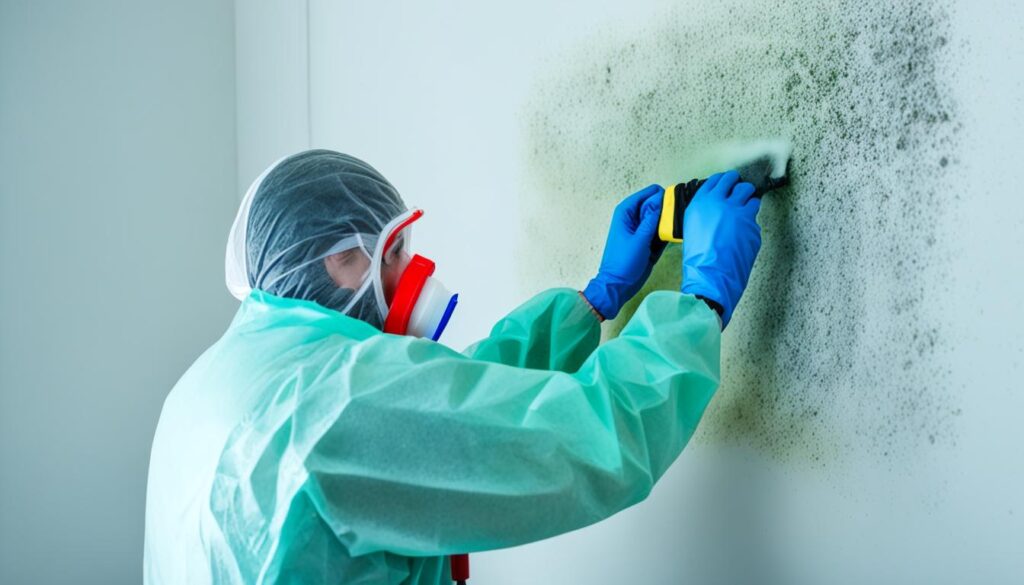
Mold Spores in Lungs: Risks & Safety Measures
Welcome to our informative article on mold spores in lungs and the associated health implications. Mold spores are microscopic particles released into the air by mold growth. When inhaled, these spores can pose risks to respiratory well-being, particularly for individuals with allergies or asthma.
In the following sections, we will explore the potential health implications of mold spores in the lungs and provide essential safety measures to protect yourself and your loved ones. By understanding these risks and implementing the necessary precautions, you can maintain a healthy living environment.
Key Takeaways:
- Exposure to mold spores in the lungs can have adverse effects on respiratory health.
- Mold spores can trigger allergies and exacerbate conditions such as asthma.
- Proper ventilation and moisture control are crucial in preventing mold growth.
- Air filtration systems can help remove mold spores from the air.
- Seek professional mold remediation services for effective removal and prevention.
Understanding the Health Implications of Mold Spores in Lungs
When it comes to the presence of mold spores in the lungs, it is crucial to be aware of the potential health implications. Mold spores, which are tiny airborne particles released by fungi, can have detrimental effects on the respiratory system, especially when inhaled.
One of the primary concerns associated with mold spores is their ability to trigger allergies. When mold spores enter the respiratory system, they can cause an allergic reaction in susceptible individuals. Symptoms may include coughing, sneezing, nasal congestion, and itchy or watery eyes. Additionally, prolonged exposure to mold spores can worsen pre-existing allergies, leading to more severe symptoms.
Asthma sufferers are particularly vulnerable to the health effects of mold spores. Inhaling mold spores can trigger asthma attacks and exacerbate existing respiratory symptoms. Mold spores can irritate the airways, causing inflammation and constriction, which can result in wheezing, chest tightness, and difficulty breathing.
To further understand the impact of mold spores on respiratory health, it is essential to be aware of their ability to release mycotoxins. Mycotoxins are toxic substances produced by certain molds and can have various adverse effects on human health. Inhalation of mycotoxins can lead to respiratory problems, neurological symptoms, immune system dysfunction, and even long-term health complications.
To protect your respiratory well-being, it is vital to take proactive measures to prevent mold growth and minimize your exposure to mold spores. This may include maintaining proper ventilation in your home, controlling moisture levels, regularly cleaning and drying areas susceptible to mold, and seeking professional mold remediation services when necessary.
It is important to note that mold spores are not always visible to the naked eye, and their presence may go unnoticed. Therefore, if you experience respiratory symptoms or suspect mold contamination in your living environment, it is best to consult with a healthcare professional and consider testing for mold presence.
By understanding the health implications of mold spores in the lungs and taking appropriate precautions, you can safeguard your respiratory system, minimize allergies and asthma symptoms, and promote overall well-being.

Safety Measures to Protect Against Mold Spores in Lungs
When it comes to safeguarding your respiratory well-being, implementing proper safety measures is crucial. In this section, we will explore essential steps you can take to protect yourself from mold spores in the lungs.
Preventive Measures
To prevent the growth and spread of mold spores in your environment, it is important to focus on mold prevention. Here are some preventive measures you can follow:
- Maintain proper ventilation in your home or workplace. Adequate airflow helps in reducing moisture buildup, which is a breeding ground for mold.
- Control the indoor humidity levels. It is recommended to keep the humidity below 50% to inhibit mold growth.
- Regularly inspect and promptly repair any leaks, water damage, or plumbing issues to prevent moisture accumulation.
- Ensure proper insulation and sealing of windows, doors, and other openings to prevent moisture intrusion.
Air Filtration Systems
In addition to preventive measures, implementing effective air filtration systems can help in reducing the presence of mold spores in the air you breathe. High-quality air purifiers equipped with HEPA (High-Efficiency Particulate Air) filters can capture and remove mold spores, providing cleaner and healthier indoor air.
Professional Mold Remediation
In cases where mold infestation has already occurred, it is essential to seek professional mold remediation services. Certified professionals have the expertise and equipment necessary to effectively identify, remove, and prevent the recurrence of mold spores. Hiring professionals ensures thorough remediation and minimizes the risk of exposure to mold.
“Proper ventilation, moisture control, and professional remediation play a vital role in protecting against mold spores in the lungs.” – Dr. Jennifer Miller, Environmental Health Expert
Safeguarding your respiratory well-being requires taking proactive measures to prevent and address mold spores. By following the safety measures outlined above, you can create a healthier living environment and minimize the risks associated with mold exposure.

Conclusion
Throughout this article, we have discussed the potential dangers of mold spores in the lungs and the importance of taking safety measures to protect your respiratory well-being. It is crucial to recognize the health risks associated with exposure to mold spores, which can lead to various respiratory issues and worsen existing conditions such as allergies and asthma.
To ensure your safety, it is vital to implement proper safety measures. This includes maintaining a clean and dry environment by controlling moisture and humidity levels in your home or workplace. Adequate ventilation, such as using exhaust fans in bathrooms and kitchen areas, can also help prevent the buildup of mold spores.
Investing in an air filtration system is another effective safety measure. These systems can help remove mold spores and other airborne pollutants, ensuring clean and healthy indoor air. Additionally, seeking professional mold remediation services when necessary is crucial for thorough mold removal and prevention, as experts have the expertise and tools to handle the situation effectively.




